Short rifles followed smokeless powder. Brakes and now suppressors add inches but not velocity!
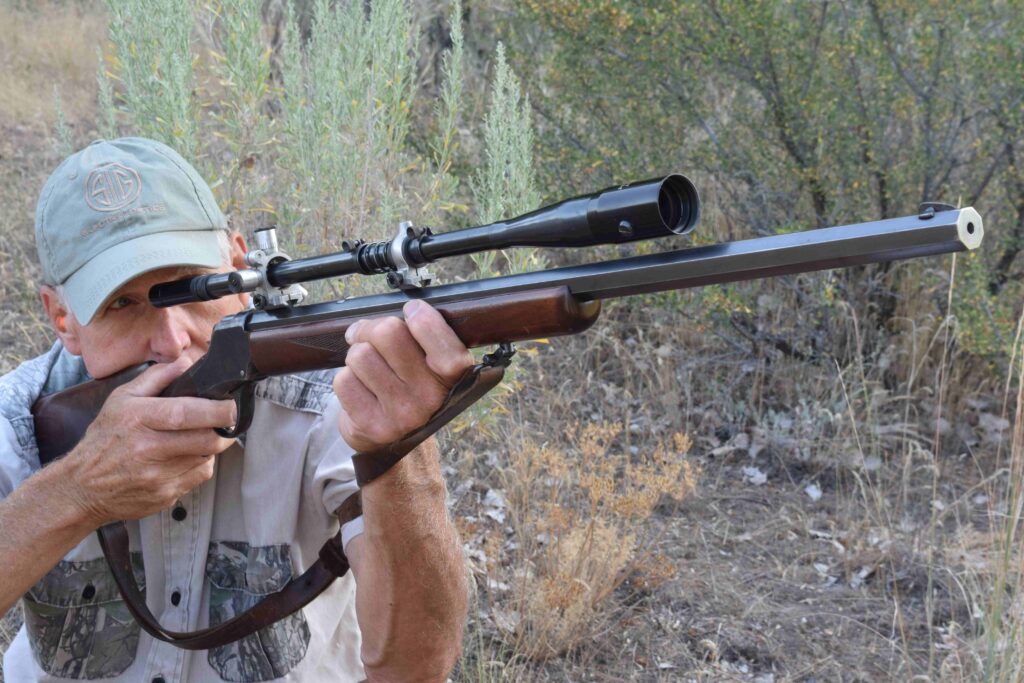
Casual rustles became purposeful steps: hyphens of silence between limb-snaps. I climbed fast to intercept the herd. Flickers of tan in the mustard aspens slowed my step. An ivory antler winked. The elk were outpacing me.
Then I got lucky.
On their flank, a raghorn bull stopped in shadow. Easing into the thicket, I brought the carbine to cheek, found a patch of neck behind a lattice of leaves and twigs. At 13 steps the animal collapsed to the bark of my .30-30. The herd crashed away.
Hunting where cover limits your step and vision, a short-barreled rifle is an asset. Long shots beg long barrels to accelerate bullets ahead of big charges of slow-burning powder. Historically, barrel lengths have changed to match tasks, loads and sights. They’ve also been influenced by the horse.
The word “carbine,” now a loose label for short-barreled rifles, comes from the French carabine, a firearm borne by lightly equipped cavalry. These horsemen were known as carabineers or carabiniers. In Italy, police still go by carabinieri. But early on, as blades and lances slowly gave way to bullets, all guns were long and cumbersome. Spaniards carried the arquebus, or harquebus, into battle. Ignition for this matchlock came by way of a burning wick lowered through the barrel’s touch-hole. Each arquebusier carried on his belt a perforated box of smoldering wicks. Rate of fire was glacial.
In the 17th and 18th centuries, flint then percussion mechanisms blessed cavalry with reliable rifles practical for mounted use. By the middle of the 19th century, the greater reach and superior accuracy of rifled bores had signaled the demise of smoothbore muskets. The U.S. Model of 1842 was our last. At the same time, it became the first made of interchangeable parts. “Short Rifled Muskets” had 33-inch barrels – stubby for that day!
Barrels soon became shorter. The Confederacy’s .58-bore 1862 Richmond Carbine had a 25-inch barrel. After self-contained cartridges made loading from the saddle fast and easy, hunters and soldiers wanted shorter barrels still. The cavalry’s version of the 1859 Sharps featured a 22-inch barrel, the 1860 Spencer Carbine a 20-inch. John Browning’s lever rifles, manufactured by Winchester in the 1880s and ‘90s, sold in a range of barrel lengths. Carbines were favored not just for their scabbard-friendly form but among hunters who appreciated their light weight and agility in thickets.
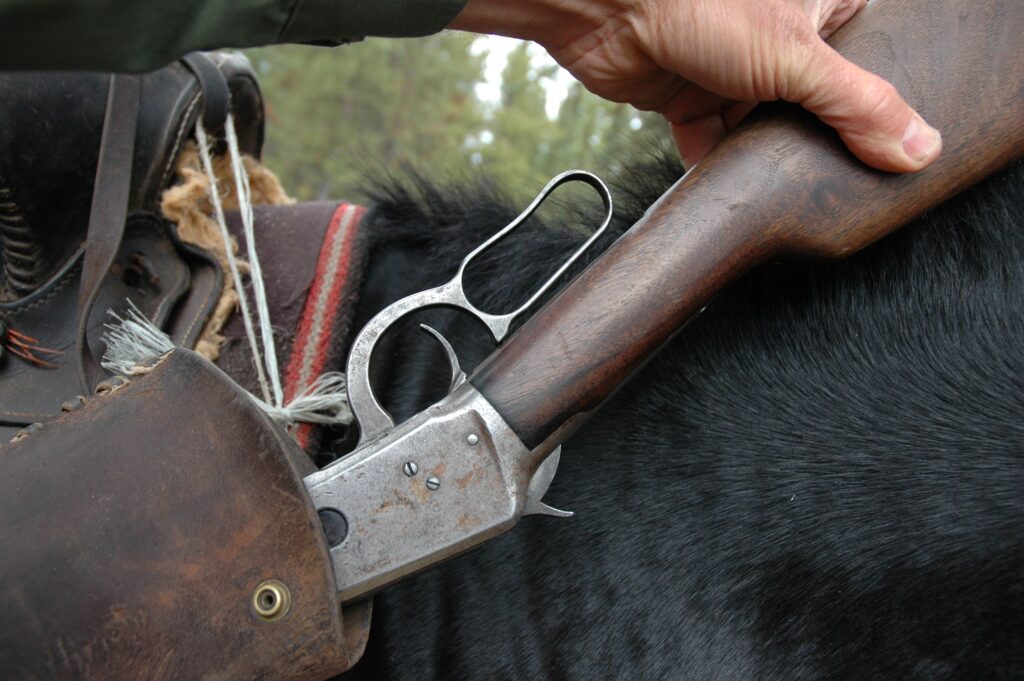
Saddle-gun! Winchester’s popular slab-sided 94 carbine with 20-inch barrel is agile in deer cover too.
As smokeless powder replaced black, the carbine shared billing with the “short rifle.” Currently reproduced by Miroku for Winchester, and by Italian shops for the likes of Cimarron and Taylor’s, these two types of short-barreled arms have much in common – and distinctions. The short rifle was originally a rifle with a special-order barrel. Example: The Winchester 1886 wore a 26-inch barrel, the 1886 Carbine a 22-inch of lighter contour. But you could get a rifle-weight, carbine-length barrel on a Short Rifle, which also lacked the Carbine’s S-shaped butt-plate and barrel bands.
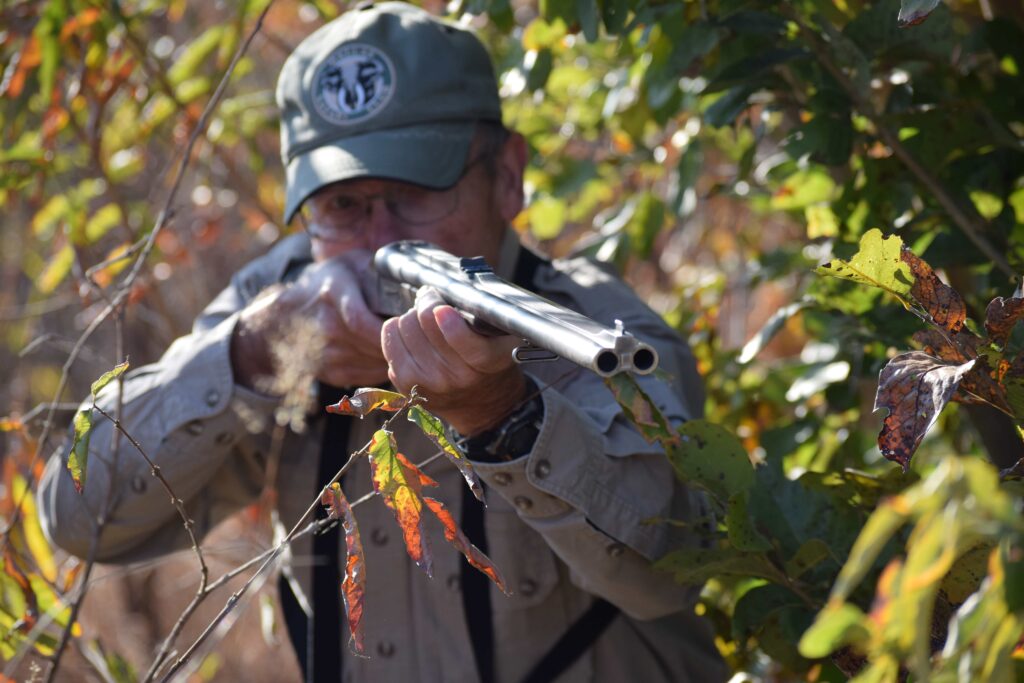
Compact boxlock actions, with fast powders and big bullets in short, twin barrels excel in buffalo cover.
The advent of small-bore, bottle-necked cartridges in bolt rifles slowed the shift to shorter barrels. Progressive-burning powders needed bore time to flex their muscle behind slender bullets. While 24-inch barrels made sense for the .30-06 and kin, 26-inch barrels were fitted to rifles for the .300 H&H Magnum.
Distinctions between “rifle” and “carbine” have blurred on bolt rifles, though lovely Mannlicher-Schoenauers from 1903 into the 1950s paired full-length stocks with Carbine barrels. In 1937 Winchester Model 70s appeared in standard chamberings with 24-inch barrels; but for its first decade a 20-inch barrel was available. This rare variation has been called a Carbine but was not so labeled by Winchester. From 1969 to 1971 Winchester built a Model 70 Mannlicher, a full-stocked rifle with 19-inch barrel. Again, no Carbine moniker. In 1984, however, a Lightweight Model 70 Carbine arrived, with a 20-inch barrel.
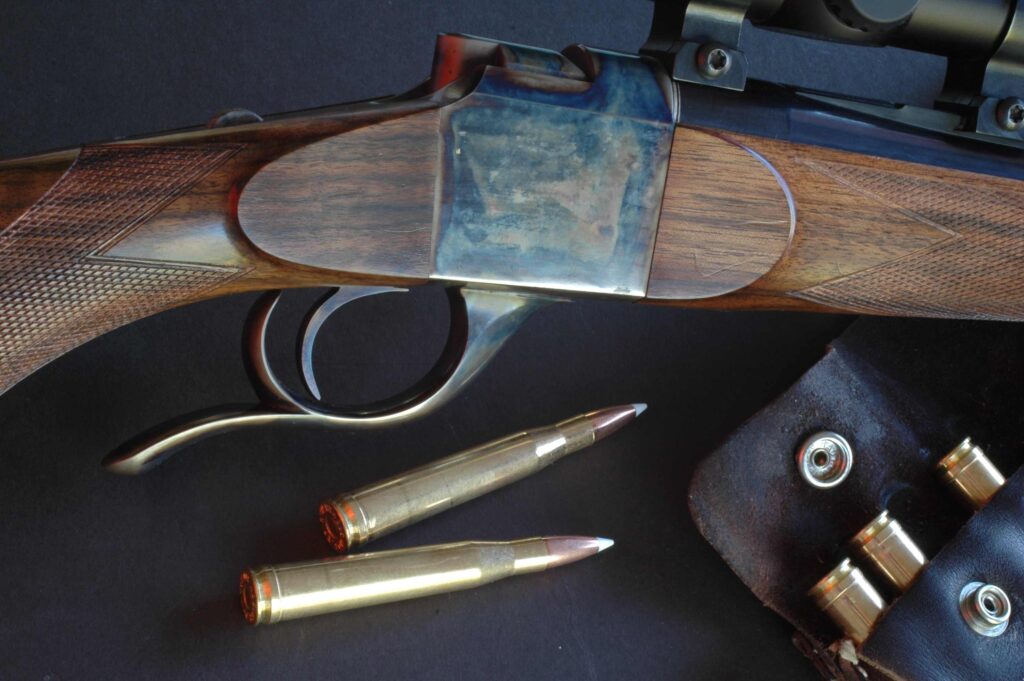
A short Hagn action gives this .300 H&H with 26-inch barrel the OAL of a bolt rifle with a 22-inch.
Savage followed no rigid protocol naming its Model 99 lever rifles. The 99E Carbine announced in 1960 had a 22-inch barrel; but the 99H rifle, 55 years old at that time, had a 20-inch!
Remington 760 pump and 740/742 autoloaders popular with deer hunters in the 1950s and ‘60s came in Rifle (22-inch) and Carbine (18 ½-inch) versions. Ruger’s self-loading .44 Magnum Deerstalker with 18 ½-inch barrel, was pitched as a Carbine at its 1959 debut. Ruger announced a .44 Magnum lever-action Model 96 Carbine in 1996.
Through the Korean War, combat rifles hewed to traditional definitions of rifle and carbine. The M1 Garand, the infantry rifle that brought the U.S. victory in Europe and the Pacific, is much longer and heavier than the M1 Carbine, which gave support staff and vehicle crews a compact arm with more reach than the 1911 pistol. The Garand’s .30-06 cartridge is much more powerful than the .30 Carbine round.
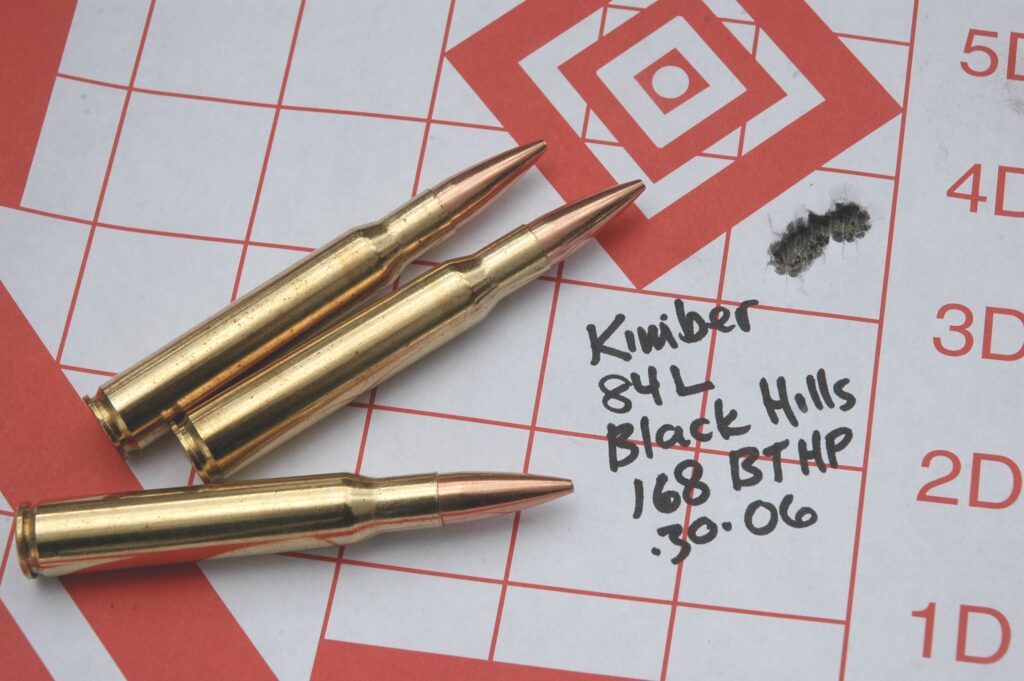
Short, slender barrels inaccurate? Hardly! Wayne shot this 100-yard group with a 5 ½-pound Kimber
Velocity is higher with long barrels until they’re so long that friction exceeds the push of the fuel. A .22 Long Rifle bullet gains no speed after about 16 inches of bore travel. The thrust of its tiny charge of fast-burning powder is quickly swallowed by the increasing space behind the bullet. Bore friction in long-barreled .22s actually slows the bullets before they exit! Hornady’s Dave Emary claimed the .17 Mach 2 and .17 HMR bullets reach top speed in about 17 inches of travel. High bore/case capacity ratios of black- powder and handgun cartridges also argue for short barrels. But big bottleneck cases with slow smokeless powders that hurl slim bullets benefit from long barrels.
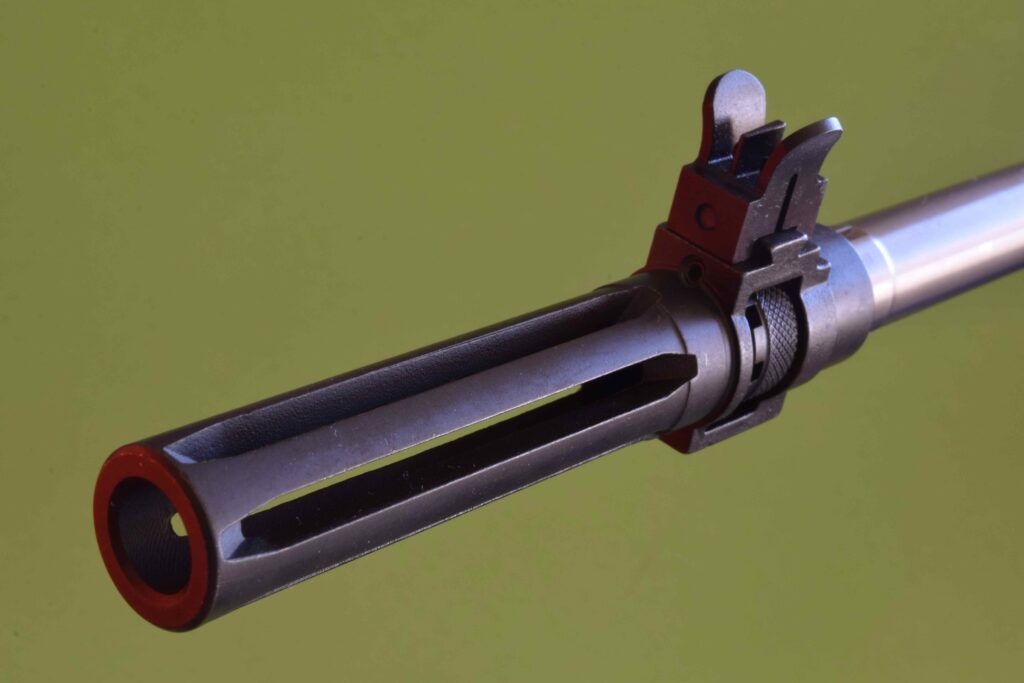
A flash-hider, here on a Springfield M1A, adds length, no boost to bullets. A useful feature in combat.
How much bullet speed you lose with each inch cut from a barrel depends on the original length, and on the load. The only sure way to determine the effects of changing barrel length is to incrementally chop a long barrel shorter. In tests by A-Square, a barrel in .300 Winchester Magnum was shortened in 2-inch increments from 28 to 16 inches. Loads of 70.5 grains IMR 4350 pushing 150-grain Nosler Ballistic Tips, and 78.0 grains RL-22 sending 180-grain Sierra spitzers gave these results:
barrel length 150-grain velocity, fps 180-grain velocity, fps velocity loss, 150/180
28 inches 3346 3134
26 inches 3268 3089 78/45
24 inches 3211 3016 57/73
22 inches 3167 2966 44/50
20 inches 3108 2930 59/36
18 inches 3014 2874 94/56
16 inches 2903 2748 111/126
Velocity loss per inch of barrel length varies from a low of 22 fps to a high of 56 fps for the 150-grain bullet, 18 fps to 63 fps for the 180-grain bullet. Rate of velocity loss increases substantially as this barrel is chopped shorter than 20 inches – that is, as trimming intrudes on the bell of the pressure curve.
Cartridge-specific propellants can reduce velocity loss in short barrels. Hornady’s .300 and .338 RCM cartridges were designed specifically for carbine-length barrels. Mitch Mittelstaedt, who headed that project, told me proprietary powders enabled his team to “tighten pressure curves so the .300 RCM behaves like ordinary .30 magnums in 24-inch barrels but doesn’t lose as much enthusiasm in carbines.” He said velocities of .300 WSM bullets fall 160 to 180 fps when barrels are lopped from 24 to 20 inches, but “velocity loss with the .300 RCM is just 100.” My Oehler chronograph confirmed that, with readings around 2,840 fps for factory-loaded 180-grain RCM bullets from the 20-inch barrel of a Ruger Hawkeye.
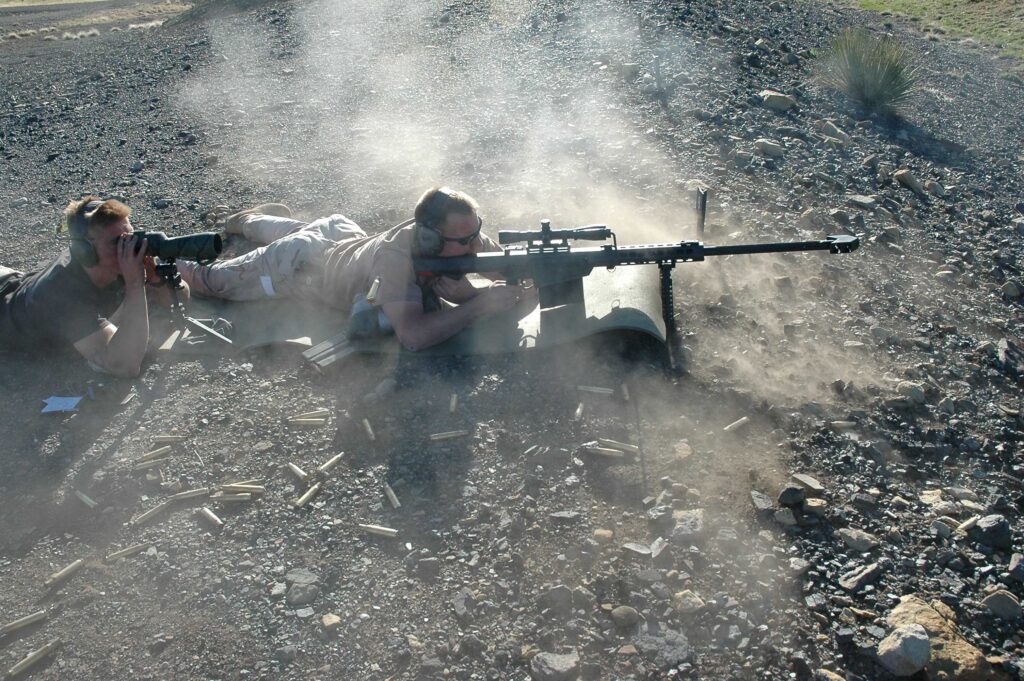
The .50 BMG cartridge begs a long barrel and a brake. Dust here shows the effect of the brake’s blast.
Surely most hunters who grew up hunting deer with 20-inch barrels on lever-action carbines have accepted the 22-inch barrels now common on bolt-action rifles. Even 24 inches makes sense to most deer hunters. In open places, 26-inch barrels hurry bullets from small- and medium-bore magnums. But brakes and suppressors are adding more barrel length – without hiking velocity.
As early as 1903, Springfield Armory experimented with brakes to reduce recoil. These devices vent gas to the sides or peripherally just shy of the muzzle. While the prototypes worked and added only a couple of inches to a Springfield’s barrel, the increased blast nixed their adoption on U.S. infantry rifles. (Brakes did appear on 40,000 Lewis aircraft machine guns during the Great War, our first military use of ported muzzles to mitigate recoil.) Soldiers using the new Browning Automatic Rifle in “full auto” mode reduced barrel climb by judicious beveling of the upper edge of the flash hider.
After the war, Marine Colonel Richard M. Cutts designed a brake dubbed the Cutts Compensator for the Thompson submachine gun. Lyman Gunsight picked it up after the war and refined it for shotguns.
Only Russia’s autoloading Tokarev among infantry rifles was equipped with a brake during WW II. But not long thereafter, Johnson Automatics in Providence, Rhode Island designed a 2-ounce brake for bolt-action rifles. It reduced recoil by over 40 percent! While the noise of many brakes since is unsettling, experiments with port size, number and angle, like those by Lex Webernick of Rifles, Inc., have trimmed blast. His barrel-diameter brakes add no unsightly bulge and very little length and weight.
Suppressors mitigate noise as well as recoil. But longer and bulkier than brakes, they affect how the rifle handles. A 5-inch suppressor on a 24-inch barrel can make your rifle feel like a goose gun, even if it adds negligible weight. Increasingly rifles are fitted with suppressor-ready barrels of modest length, their threaded muzzles protected by unobtrusive caps. Matched to the weight of the suppressor (or brake), the cap also guards against point of impact shift when the device is removed.
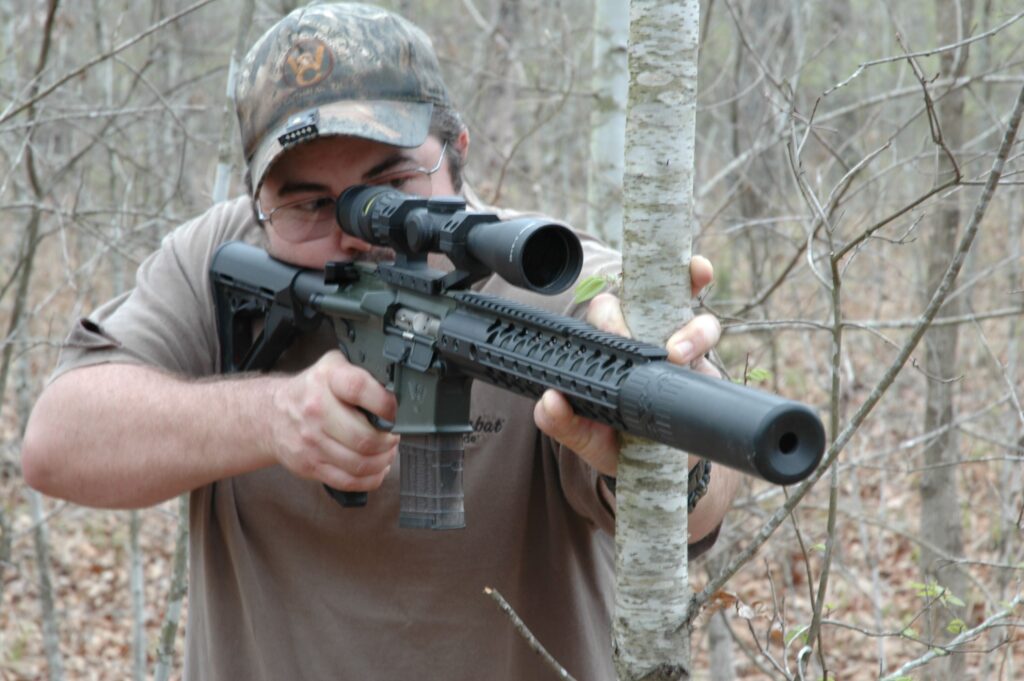
Despite its suppressor, Ryan’s short-barreled Wilson Combat AR is nimble and quick to point in “hog cover.” It’s also well paired with Bill Wilson’s 30-caliber cartridge on the .223 case.
Given probable use with a suppressor, some threaded barrels are shorter than optimal for modern high-performance cartridges, limiting velocity to no purpose while bringing muzzle blast closer to your ears. Unlike our late-19th-century forebears who snatched up carbines to cradle or to slide into a scabbard, we now must weigh ballistic performance against the benefits of suppressors.
Questions about barrels, brakes, suppressors? Ask the knowledgeable staff at Midsouth Shooters Supply, a first stop for what you need and what you need to know!
Sidebar: What about accuracy?
Long barrels add no accuracy to modern cartridge rifles. Indeed, short barrels are stiffer than long ones of the same diameter, so move less during bullet passage. You’ll see few long barrels at Bench Rest matches. Bolt-action pistols can be exceedingly accurate.
Incidentally, for hunting, beefy barrels are no more accurate than slender ones, though thin barrel walls have more flex and are typically not as consistent during extended strings of “hot-barrel” fire. Gun-maker D’Arcy Echols confirms his .270 barrels with a muzzle diameter of just .544 drill half-inch groups – as do his light-weight .30 magnum rifles with .560 muzzles. Fluting reduces the weight of thick-walled barrels with little cost in stiffness.








